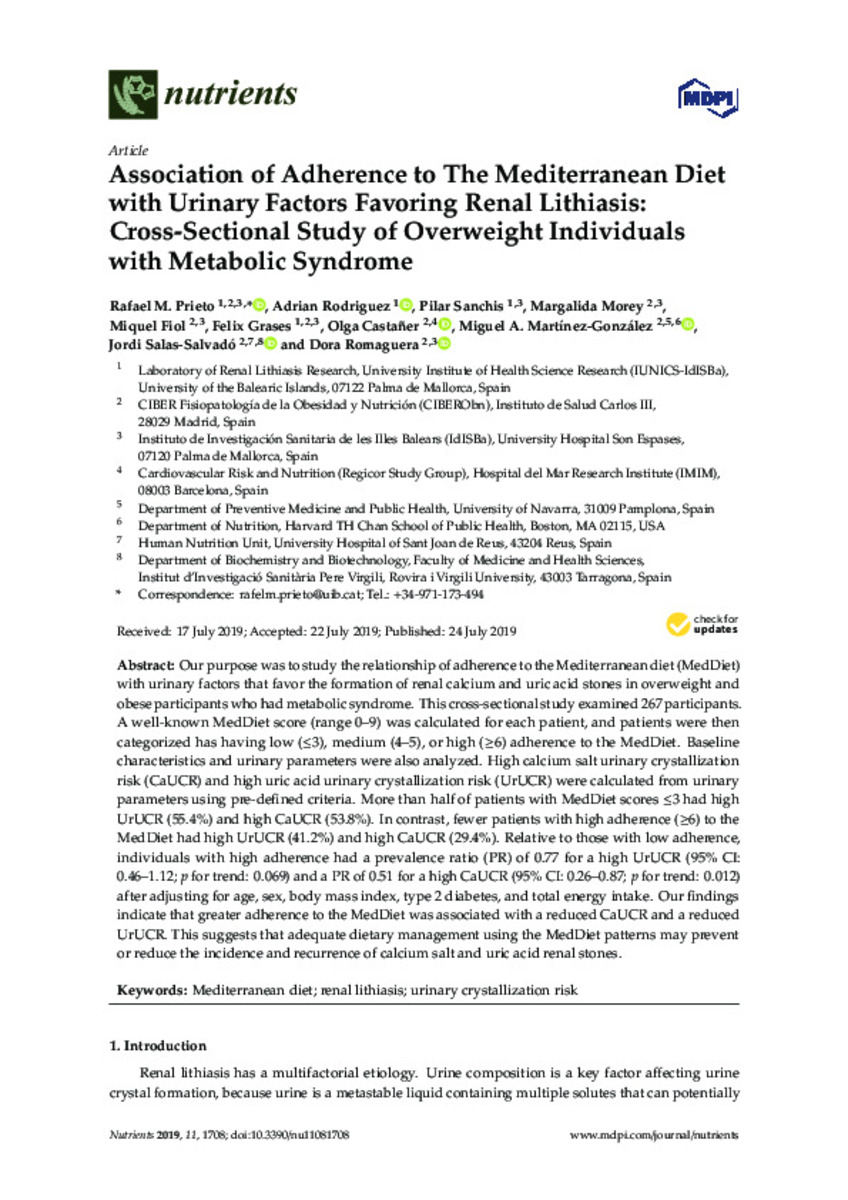Full metadata record
| DC Field | Value | Language |
|---|---|---|
| dc.creator | Prieto, R.M. (Rafael M.) | - |
| dc.creator | Rodríguez, A. (Adrián) | - |
| dc.creator | Sanchís, P. (Pilar) | - |
| dc.creator | Morey, M. (Marga) | - |
| dc.creator | Fiol, M. (Miquel) | - |
| dc.creator | Grases, F. (Félix) | - |
| dc.creator | Castañer, O. (Olga) | - |
| dc.creator | Martinez-Gonzalez, M.A. (Miguel Ángel) | - |
| dc.creator | Salas-Salvado, J. (Jordi) | - |
| dc.creator | Romaguera, D. (Dora) | - |
| dc.date.accessioned | 2021-09-23T09:44:04Z | - |
| dc.date.available | 2021-09-23T09:44:04Z | - |
| dc.date.issued | 2019 | - |
| dc.identifier.citation | Prieto, R.M. (Rafael M.); Rodríguez, A. (Adrián); Sanchís, P. (Pilar); et al. "Association of Adherence to The Mediterranean Diet with Urinary Factors Favoring Renal Lithiasis: Cross-Sectional Study of Overweight Individuals with Metabolic Syndrome". Nutrients. 11 (1708), 2019, 1 - 10 | es_ES |
| dc.identifier.issn | 2072-6643 | - |
| dc.identifier.other | PMID: 31344950 | - |
| dc.identifier.uri | https://hdl.handle.net/10171/62056 | - |
| dc.description.abstract | Our purpose was to study the relationship of adherence to the Mediterranean diet (MedDiet) with urinary factors that favor the formation of renal calcium and uric acid stones in overweight and obese participants who had metabolic syndrome. This cross-sectional study examined 267 participants. A well-known MedDiet score (range 0-9) was calculated for each patient, and patients were then categorized has having low (≤3), medium (4-5), or high (≥6) adherence to the MedDiet. Baseline characteristics and urinary parameters were also analyzed. High calcium salt urinary crystallization risk (CaUCR) and high uric acid urinary crystallization risk (UrUCR) were calculated from urinary parameters using pre-defined criteria. More than half of patients with MedDiet scores ≤3 had high UrUCR (55.4%) and high CaUCR (53.8%). In contrast, fewer patients with high adherence (≥6) to the MedDiet had high UrUCR (41.2%) and high CaUCR (29.4%). Relative to those with low adherence, individuals with high adherence had a prevalence ratio (PR) of 0.77 for a high UrUCR (95% CI: 0.46-1.12; p for trend: 0.069) and a PR of 0.51 for a high CaUCR (95% CI: 0.26-0.87; p for trend: 0.012) after adjusting for age, sex, body mass index, type 2 diabetes, and total energy intake. Our findings indicate that greater adherence to the MedDiet was associated with a reduced CaUCR and a reduced UrUCR. This suggests that adequate dietary management using the MedDiet patterns may prevent or reduce the incidence and recurrence of calcium salt and uric acid renal stones. | es_ES |
| dc.description.sponsorship | This research was funded by Instituto de Investigación en Salud Carlos III, grants numbers PI14/00853 and PI17/00525—co-funded by European Regional Development Fund (FEDER), Centro de Investigación Biomédica en Red (CIBEROBN), grant number CB06/03/0043 and European Research Council (ERC), grant number 340918. | es_ES |
| dc.language.iso | eng | es_ES |
| dc.publisher | MDPI AG | es_ES |
| dc.relation | info:eu-repo/grantAgreement/EC/FP7/340918/EU | es_ES |
| dc.rights | info:eu-repo/semantics/openAccess | es_ES |
| dc.subject | Materias Investigacion::Ciencias de la Salud::Medicina preventiva | es_ES |
| dc.subject | Mediterranean diet | es_ES |
| dc.subject | Renal lithiasis | es_ES |
| dc.subject | Urinary crystallization risk | es_ES |
| dc.title | Association of Adherence to The Mediterranean Diet with Urinary Factors Favoring Renal Lithiasis: Cross-Sectional Study of Overweight Individuals with Metabolic Syndrome | es_ES |
| dc.type | info:eu-repo/semantics/article | es_ES |
| dc.description.note | This article is an open access article distributed under the terms and conditions of the Creative Commons Attribution (CC BY) license (http://creativecommons.org/licenses/by/4.0/). | es_ES |
| dc.identifier.doi | 10.3390/nu11081708 | - |
| dadun.citation.endingPage | 10 | es_ES |
| dadun.citation.number | 1708 | es_ES |
| dadun.citation.publicationName | Nutrients | es_ES |
| dadun.citation.startingPage | 1 | es_ES |
| dadun.citation.volume | 11 | es_ES |
Files in This Item:
Statistics and impact
Items in Dadun are protected by copyright, with all rights reserved, unless otherwise indicated.






